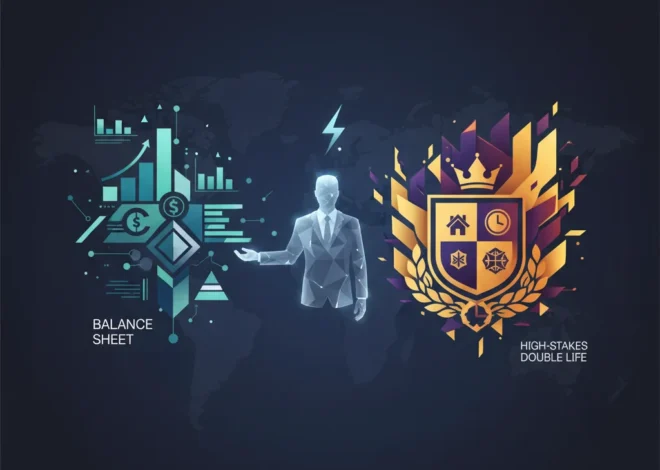
Geopolitical Tremors: A High-Stakes Ultimatum in Ukraine and the Financial Shockwave Ahead
In a move that has sent shockwaves through the corridors of power from Washington to Brussels and beyond, envoys representing former U.S. President Donald Trump have reportedly delivered a stark ultimatum to Ukraine. According to a bombshell report from the Financial Times, Ukrainian officials were presented with a hardline message during a volatile meeting in Kyiv: agree to a proposed U.S.-Russia peace plan by Thursday, or face the consequences. This development, sparking immediate alarm among European allies, is more than a geopolitical gambit; it is a seismic event with profound and immediate implications for the global economy, international finance, and every investor’s portfolio.
For business leaders, finance professionals, and investors, moments like these are critical inflection points. The delicate balance of global stability, which underpins predictable market behavior and economic forecasting, has been violently shaken. Understanding the nuances of this ultimatum—the potential terms of the deal, the reactions of key players, and the cascading economic effects—is no longer an academic exercise. It is essential for navigating the turbulent waters of the global stock market and making informed decisions in an era defined by unprecedented uncertainty.
Deconstructing the Ultimatum: A Look Inside the Kyiv Meeting
The core of the issue stems from a high-stakes, closed-door meeting in the Ukrainian capital. The message delivered was allegedly unambiguous, reflecting a transactional approach to foreign policy. While the full details of the proposed “peace plan” remain shrouded in secrecy, sources cited in the initial report suggest it involves significant concessions that many in Ukraine and Western Europe would find untenable. The hardline nature of the delivery has been described as a “take-it-or-leave-it” offer, a diplomatic maneuver designed to force a swift resolution, regardless of the long-term strategic costs.
This approach has, unsurprisingly, caused considerable consternation among European Union members. For nations on the continent, the security architecture of the past several decades is at stake. A peace deal brokered under duress and potentially favorable to Russian strategic interests could undermine NATO’s solidarity and create a deeply unstable precedent. The divergence between this purported U.S. plan and the EU’s long-term strategy for regional security highlights a growing rift in transatlantic policy, a factor that introduces yet another layer of risk into the global economics of trade and security alliances.
The swiftness of the deadline—a mere matter of days—is designed to maximize pressure and minimize deliberation. It prevents the formation of a unified counter-position and forces a decision under extreme duress. This tactic, while potentially effective in the short term, risks creating a fragile and unsustainable peace, the collapse of which could be even more devastating for the global economy than the current conflict.
The Great Bitcoin Gamble: Is MicroStrategy's Michael Saylor a Visionary or a Zealot?
The Economic Fallout: Gauging the Impact on Markets and Investments
For investors, the immediate question is how this geopolitical earthquake will translate into market tremors. The initial reaction is often a flight to safety. We can anticipate increased volatility in equity markets as uncertainty reigns. Investors may pull capital from riskier assets and move into traditional safe havens like the U.S. dollar, Swiss franc, and gold. This shift can have a significant impact on currency trading and international capital flows.
The energy sector, in particular, stands at a precipice. A potential peace deal could, in theory, stabilize energy prices by restoring some predictability to supply chains. However, the terms of such a deal are critical. If it involves the easing of sanctions on Russian energy exports, it could lead to a drop in oil and natural gas prices, impacting energy stocks and the economies of producer nations. Conversely, a rejection of the deal and a potential escalation of the conflict would almost certainly send energy prices soaring, fueling global inflation and putting further pressure on central banking institutions to maintain hawkish monetary policies.
To better visualize the potential outcomes, consider the following scenarios:
| Economic Factor | Scenario A: Peace Deal Accepted | Scenario B: Ultimatum Rejected / Conflict Escalates |
|---|---|---|
| Global Stock Market | Short-term relief rally, followed by uncertainty over the deal’s stability. Sector rotation towards reconstruction and consumer goods. | Sharp increase in volatility (VIX). Broad market sell-off, with defense and cybersecurity stocks potentially outperforming. |
| Energy Prices (Oil & Gas) | Potential for price moderation if Russian supplies are gradually reintroduced to the market. High uncertainty. | Significant price spike due to supply fears and increased geopolitical risk premium. |
| Inflation & Monetary Policy | Possible easing of inflationary pressures, giving central banks more flexibility. | Renewed inflationary surge, forcing central banks to maintain or increase interest rates, risking recession. |
| Global Trade & Supply Chains | Partial normalization of trade routes, but long-term realignment of supply chains away from geopolitical hotspots continues. | Further disruption to shipping, agriculture, and manufacturing supply chains. Increased costs for businesses. |
A New Financial Architecture? Sanctions, Banking, and Technology
Beyond the immediate market jitters, this event forces a deeper conversation about the future of the global financial system. The extensive sanctions regime imposed on Russia has been a defining feature of this conflict, demonstrating the power of weaponized finance. A peace agreement would necessitate a decision on the future of these sanctions. A phased rollback could be used as a carrot to ensure compliance, but it would be a complex and contentious process, with profound implications for the global banking sector.
This crisis has also accelerated conversations around alternatives to the SWIFT messaging system and the dominance of the U.S. dollar. Nations wary of being subjected to similar financial pressures are actively exploring bilateral trade in local currencies and investing in alternative payment infrastructures. This is where financial technology (fintech) enters the picture. The development of Central Bank Digital Currencies (CBDCs) and other digital payment platforms could be fast-tracked as a means of creating financial corridors that are less susceptible to Western sanctions.
While still a nascent and speculative area, the role of blockchain and decentralized finance cannot be entirely dismissed. In a world of fractured trust and financial warfare, the appeal of transparent, censorship-resistant networks for value transfer could grow. Whether for tracking reconstruction aid with auditable transparency or for illicit actors to circumvent sanctions, the technology’s relevance in this new geopolitical paradigm is a subject of intense debate within both policy and tech circles.
Neom: A Visionary Investment or a Multi-Trillion Dollar Mirage?
The Investor’s Playbook: Navigating a High-Stakes World
So, what should a prudent investor or business leader do in the face of such monumental uncertainty? Panic is never a strategy. Instead, a disciplined and informed approach is paramount.
- Re-evaluate Geopolitical Risk Exposure: This is no longer a theoretical risk. Actively assess your portfolio’s or company’s exposure to the region and, more broadly, to assets highly correlated with geopolitical stability. Diversification is not just about asset classes anymore; it’s about geographic and political diversification.
- Focus on Resilient Sectors: Companies with strong balance sheets, pricing power, and essential products or services are better positioned to weather economic storms. Sectors like cybersecurity, defense, and energy infrastructure may see sustained interest regardless of the outcome, as noted by numerous market analyses (source).
- Monitor Key Indicators: Keep a close watch on commodity prices (especially oil, gas, and wheat), currency exchange rates (particularly EUR/USD), and bond yields. These are the financial system’s early warning signals, and their movements will provide clues about the market’s real-time assessment of the situation.
- Embrace Long-Term Themes: While short-term trading will be fraught with volatility, long-term investment themes may become clearer. The drive for energy independence in Europe, the onshoring of critical supply chains, and increased defense spending are powerful secular trends that will likely persist for years to come.
The Billion-Dollar Glitch: How a Cyber-Attack Drove Jaguar Land Rover into the Red
The ultimatum delivered in Kyiv is a stark reminder that we live in an era where political events can reshape the financial landscape overnight. The coming days will be critical, not just for the people of Ukraine, but for the stability of the global economy. For those of us tasked with navigating the markets, the message is clear: the age of complacency is over. Vigilance, adaptability, and a deep understanding of the interplay between power politics and finance are now the most valuable assets in any portfolio.


